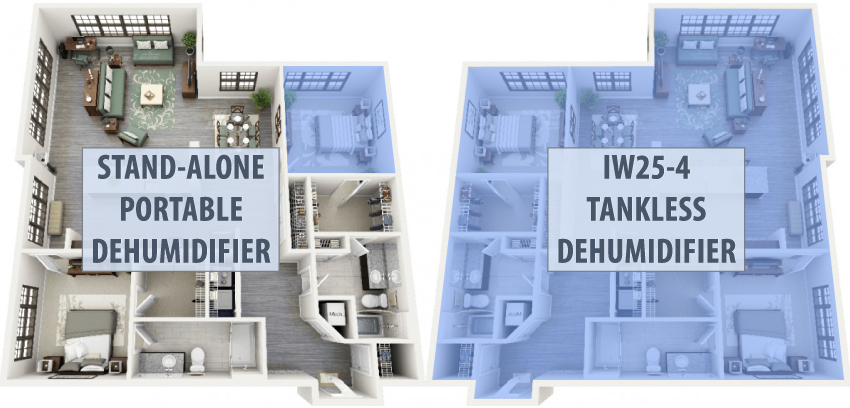UPDATED: November 29, 2021

Portable Dehumidifier vs. IW25 Tankless Dehumidifier
A healthy and comfortable living environment are primary considerations for many tenants and should be mutual goals for every developer, contractor, and owner. Unfortunately, maintaining comfort while providing healthy ventilation can be a difficult task to juggle. Especially since housing requirements have become more energy-efficient, requiring tighter envelopes as well as ventilation that introduces outside air indoors, which allows humid air from outside a direct route indoors (ENERGY STAR® Multifamily New Construction Program).
“Tighter building construction practices save energy, they also can create an environment of stagnant air that is highly hospitable to mold.”1
According to Aaron M. Cooper’s thesis, “tighter building construction practices save energy, they also can create an environment of stagnant air that is highly hospitable to mold.”1 After extensive research and years of hands-on field experience, Brian Smith, Multi-family General Contractor and Developer, discovered how to help prevent the problems associated with moisture trapped in the multi-family housing projects he builds.
“Elevated relative humidity at a surface . . . can lead to problems with mold,
corrosion, decay and other moisture related deterioration.”
– Lstiburek J., Relative Humidity2
“Remove moisture, lower humidity. It isn’t rocket science. It’s simply taking the time to find the cause of a problem to understand the solution.” explains IDS owner, Brain Smith at a Virginia Conference hosted by the VDHA. “As the General Contractor and Developer of apartment complexes in several southeastern states, I was tired of being pulled into litigation, meetings, and people pointing the finger at me. As a builder, I knew I built my buildings correctly. As a developer remediation and tenant replacement costs were adding up.” The key is finding a SOLUTION… “prevent indoor mold growth by controlling moisture in the air,” as stated by Lee, H.J. and Peart V., Basic Mold Prevention.3
The key is finding a SOLUTION… “prevent indoor mold growth by controlling moisture in the air.”3
Moisture Removal
With the knowledge and understanding of what causes high indoor humidity, he began searching for the best way to remove excess moisture in apartments. At the time he began his research in 2010, the options for dehumidification were limited to portable dehumidifiers or whole house dehumidifiers. Although both options are capable of removing moisture from the air, they were not dependable dehumidifiers for apartments.
At their core dehumidifiers are designed to pull in and cool down air, to condense and collect the moisture. As simple as it may sound, controlling humidity in multifamily housing has been a daunting task. Tenants often have a long list of complaints and concerns with using portable dehumidifiers including high noise levels and cost to run, the nuisance of having to empty reservoir tank, taking valuable floor space, and the extra heat they add to a room. The most important factor to consider is tenant behavior; tenants can’t be relied upon to properly maintain a portable dehumidifier, often unaware of their benefits and only think of them as an inconvenience that will raise the utility bill.

7 Reasons Portable Dehumidifiers Do Not Work for Apartments
- TENANT DEPENDANT – tenant oversees operation of unit
- LOUD – make loud and disruptive noise
- COST – too expensive to run
- RESERVOIR – tank must be manually emptied
- EYESORE – takes up floor space, creates a tripping hazard, unattractive
- HOT AIR – releases hot air back in the apartment
- OVERSIZED – pulls more than needed from a space; higher energy consumption
Limitations of Plastic Portable Dehumidifiers
Small, portable dehumidifiers are intended for use in tight spaces where direct drainage isn’t an option, such as a bedroom or closet, and are too small in both size and capacity to dehumidify more than a single room. These stand-alone dehumidifiers typically include a bucket to collect the condensed moisture and are designed to be moved from room to room depending on where high humidity is a problem. Generally, portable units are made of plastic and overtime the heavy internal components (compressor, fan motor) can break free from the housing. Due to the inexpensive cost of these standalone units, replacement parts are often not available, also keep in mind that the plastic casing is not meant to be disassembled for repairs.
Capacity at Saturation
Most small portable dehumidifiers advertise their moisture removal capacity at extreme saturation conditions 90% Relative Humidity (RH) and 90°F, which is highly unlikely for a typical home. The standard for testing the effectiveness of a dehumidifier is at average conditions, 60% RH and 80°F, the standard by the Association of Home Appliance Manufacturers (AHAM)4. This means portable dehumidifiers offer much less moisture removal than stated in typical conditions. “As a rule of thumb, a dehumidifier can extract about half as much moisture a day in AHAM conditions as it can in saturation conditions”. 4

Condensate Collection
Portable dehumidifiers are designed to pull moisture from the air that condenses over coils and collects in an internal reservoir bucket. There are some standalone dehumidifiers that offer a continuous drain option. These units pull moisture and pump out the condensate through a drain hole which is typically connected to a hose. Although this sounds like an appealing feature, these pumps do not initiate until the reservoir bucket is full and shuts off while tank is still at 50% capacity, leaving standing water in the bucket. The most important thing to understand is that “mold needs moisture to grow.”5 Portable dehumidifiers condense “moisture into a water basket, where it collects. If not emptied regularly, the stagnant water can lead to mold forming on the inside of the collection basket.”6
Portable dehumidifiers condense “moisture into a water basket, where it collects. If not emptied regularly, the stagnant water can lead to mold forming on the inside of the collection basket.”6
Keep in mind, unless a small, portable dehumidifier is emptied multiple times a day, they are counter-productive, because they hold water. Joseph Lstiburek states “Mold requires water. No water, no mold.”7 A dehumidifier without a tank, such as the IW25, includes a drain hose to automatically remove collected condensation, there is no need to empty and clean the reservoir tank.
Dependable Moisture Control
Understanding the limitations of dehumidifiers available, Brian Smith, designed and manufactured a dehumidification system for the multi-family industry. Through his research, he discovered that indoor humidity is affected by residents’ daily habits and lifestyles. Some tenants are reluctant to run ac, while others prefer to hang dry clothing, even cooking contributes to the amount of moisture in the air. It was imperative for the design to be tamper-proof in order to release responsibility from residents. This way property owners, and tenants can rest assured knowing the dehumidifier is removing moisture to keep relative humidity below 60%. The nuisances associated with portable dehumidifiers were revised to accommodate tenants’ preferences and the innovative IW25 became a reality. The IW25 tankless dehumidification system can easily install directly in or on wall, runs quietly in the background, and continuously drains without having to empty a reservoir tank.
“I’m most thankful for the little machine that is helping us breathe better.”
Eliminating moisture from the air will improve the indoor air quality, and comfort for residents. “My dehumidifier was installed Feb 3. Today is Feb. 14 and I feel so much better and I cough far less than I once was. Prior to installing the dehumidifier, I was coughing constantly. I can tell there has been a huge improvement. I smile every time I hear the machine come on (it isn’t loud at all). While the countertops and appliances look nice, I’m most thankful for the little machine that is helping us breathe better.” -satisfied tenant residing in the Southeast.
Tamper-Proof and Tankless Dehumidification for Apartments
The sleek IW25 mold defender is a dehumidifier system without a tank designed specifically for apartments up to 1,500 square feet, pulling up to 29.5 pints of moisture from even the dampest and darkest corners. The tankless system can be set up to drain automatically into a hub drain or the optional internal condensate pump (integrates directly into the IW25). The IW25 dehumidification system consistently condenses moisture without tenant participation, protecting your property and reputation.
The versatile IW25 IN Wall or ON Wall dehumidifier puts control back in your hands keeping RH below 60%. Confidently lower indoor humidity levels, improve comfort, and protect the longevity of your property with the upgraded IW25, which includes an extended 5-year warranty on parts and labor.

The Problem with High Humidity in Apartments?
Why unwanted moisture is a growing problem in apartments.
Source:
1. Cooper, Aaron M. Mold Susceptibility of Rapidly Renewable Materials used in Wall Construction. 2007. Texas A&M University, Master of Science. Core, accessed November 2021 <https://core.ac.uk/download/pdf/4276521.pdf>
2. Joseph Lstiburek, Relative Humidity, April 2002, Building Science Corporation, accessed October 2021 <https://www.buildingscience.com/documents/reports/rr-0203-relative-humidity/view>
3. Lee, H-J and Peart V. (January 2007). Basic Mold Prevention, University of Florida IFAS Extension, 1.
4. Aer Industries, October 3, 2016, AHAM vs. Saturation Explained, accessed November 2021,
<https://aerindustries.com/blog/2016/10/03/aham-vs-saturation-explained/>
5. Indoor Mold and Health: A Fungus Among Us, May 2021, Florida Health, accessed November 2021 <http://www.floridahealth.gov/environmental-health/mold/index.html>
6. Susan Paretts, December 2018, SFGATE, accessed November 2021,
<https://homeguides.sfgate.com/remove-mold-dehumidifier-water-basket-33155.html>
7.Lstiburek, Yost N., and J. Brennan, J., (2002) Mold: Causes, Health Effects and Clean-Up, Citeseer, accessed November 2021 <http://citeseerx.ist.psu.edu/viewdoc/download?doi=10.1.1.625.1632&rep=rep1&type=pdf>


